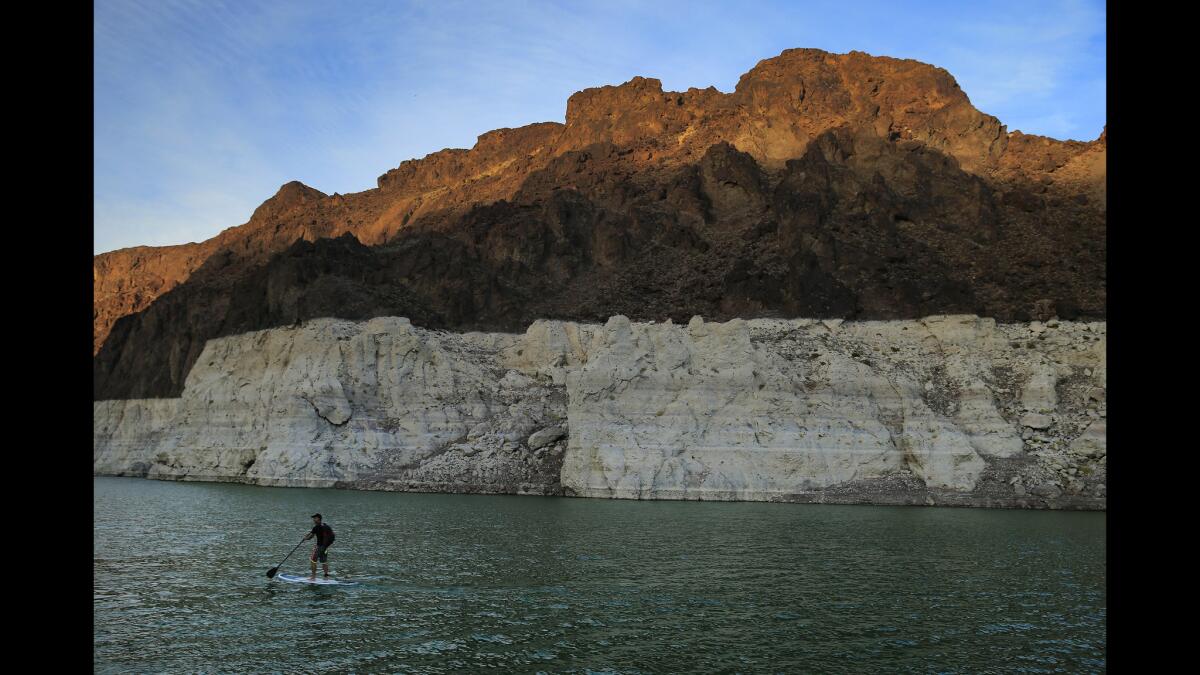Newsletter: Water and Power: Good job, California, you’re saving water
- Share via
Your guide to the California drought from the Los Angeles Times.
NASA's Jet Propulsion Laboratory is using airborne research equipment to track California's snowpack levels. The Airborne Snow Observatory flies over California and Colorado three or four times a week to measure the snow levels.
NEWS AND POLICY
Saving water: Gov. Jerry Brown called for water conservation, and Californians listened. Overall water usage dropped 29% in May. "Californians are creative. We can fix the leaks, let the lawn go brown, and take shorter showers," said Felicia Marcus, chairwoman of the State Water Resources Control Board. Water officials believe there's a social pressure involved -- it's easier to cut back when you see your neighbors and co-workers doing the same.
Unexplained increases: Officials with a handful of water districts are befuddled about dramatic increases in usage in May. One possible explanation as to why California City in Kern County saw a 28% jump could be an increase in the local prison population. At the Casitas Municipal Water District, a 26% increase could be the result of a dispute over how to calculate water for agricultural uses.
California's rain calendar: The National Weather Service is changing what it considers to be California's "rain year." For 130 years, meteorologists at the service have measured rainfall from July to June, which aligned with Southern California's climate. (The typically bone-dry months of July and August make a good starting point for record keeping.) But now the service will measure from October to September, the so-called hydrological year, enabling scientists to better measure runoff.
Driest on record: On the subject of rainfall, downtown Los Angeles just had its driest four-year period since record keeping began 138 years ago. From 2011 to 2015, only 29.14 inches of rain fell in the downtown area. From July 1, 2014, until June 30 of this year, downtown had 8.52 inches of rain, or 57% of average.
ON THE GROUND
Tourism boom: Water levels at Lake Mead are reaching historic lows, but that hasn't stopped tourists from exploring the site. Among the new discoveries are an abandoned Mormon settlement and a World War II-era bomber that sank in 1948. "With 7 million annual visitors, it draws more than the Grand Canyon, Yosemite or Yellowstone."
South of the border: With Baja California relying on the Colorado River for its water, contingency plans are being put in place for a possible water shortage. "Water managers are planning an array of measures aimed at stretching Baja California's existing supply and creating new sources -- from desalination plants to new wells and reservoirs, canal lining projects and improved irrigation techniques." However, without mandatory conservation measures in place, the seriousness of the situation hasn't yet sunk in for most residents.
High-tech help: Farmers in the Central Valley are turning to Silicon Valley for tech support in regulating irrigation systems and saving water. While some farmers, like those growing wine grapes, have embraced technology, others are more skeptical of investing thousands of dollars into brand new technology systems. "The courtship between tech entrepreneurs and farmers can be slow."
Unintended consequence: It's buyer beware if you are tearing out your lawn and planting native, drought-tolerant plants: You may unwittingly pick up an invasive plant that can cause harm to the local ecosystem. The problem may be compounded as these plants can withstand almost anything, including a drought. California's Department of Food and Agriculture lists 183 plants as invasive.
BIG IDEAS
"We have a lot of infrastructure, but a lot of it doesn't work very well anymore. We need to undertake what amounts to a giant replumbing project across the West."
-- Michael Connor, deputy secretary of Department of the Interior, on how the federal agency will have to change its mission on the West Coast in the wake of the drought.
"It's been shown -- most recently in Australia -- that making it easier for water owners and users to buy and sell their water supplies and water rights will assure that water will flow to its highest and best uses. In other words, California needs a more active water market, with more decisions made by businesses and consumers -- and fewer made by agencies responding to groups (farmers, environmentalists, big-city water users) that wield political power."
-- Reason magazine, arguing that more robust water markets can help California deal with the drought.
OFFBEAT
Creative fix: A pool repair man in a scuba suit is quickly becoming a hero to pool owners who want to save water. Kevin Wallace is able to fix swimming pools, including rust spots, rebar, structural cracks and drains, without draining all the water. The mixture of compounds he uses to repair the pools is a secret.
DROUGHT SNAPSHOT
A stand-up paddle boarder takes a sunset cruise on July 2 near Hoover Dam at the Lake Mead National Recreation Area that is shared by Nevada and Arizona. A large bathtub-like ring circles the lake, marking the former water level. (Allen J. Schaben / Los Angeles Times)
DAILY TIP
Here are a few ways to save water in your bathroom, according to Save Our Water:
-- Turn off the shower while you wash your hair.
-- Install low-flow shower heads.
-- When washing your hands, turn off the faucet while you lather.
-- Don't use your toilet as a wastebasket.
LOOKING AHEAD …
-- The State Water Resources Control Board will meet today in Sacramento.
-- The Los Angeles Board of Water and Power Commissioners is expected to meet Wednesday to talk about possible rate increases.
Please let us know what we can do to make this newsletter more useful to you. Send comments, complaints and ideas to Alice Walton or Shelby Grad.

